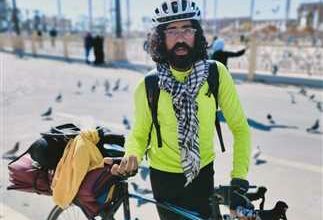As struggles with clogged traffic, poor urban planning and dense pollution continue, Egypt’s diverse bicycle-riding community is slowly on the rise, making the most of a means of transport that is gaining in popularity for a wide variety of reasons.
Whether it be minimizing time spent in traffic, lowering daily travel costs or trying to take a more eco-friendly approach to life, the need for Egyptians to consider non-motorized forms of transport is becoming more apparent by the day.
“I started to ride my bike daily because I grew increasingly tired of meaningless traffic and limited parking,” says Zena Sallam, a young Cairene who recently switched to bike riding as her favorite mode of conveyance.
“Totally silent, zero carbon emissions, a form of exercise, with a basket, and small enough to fit between cars in bumper-to-bumper traffic; it is the perfect Cairo vehicle,” she says.
Zena’s enthusiasm is shared by many other riders. In 2008, an organization known as the Cairo Cycler's Club (CCC) was founded by a bunch of passionate cyclists willing to spread the benefits of riding bikes through awareness events and group trips.
“Three years ago, we were only about four people participating,” says Mostafa Hussein, founder and administrator of the club. “Now, the number is easily in the hundreds. Some people just love cycling. But for others, sitting for hours in traffic every day and wasting your salary on petrol is no longer bearable.”
In 2010, the group organized an event in collaboration with 350.org – a grassroots movement established to address the global climate crisis – by which cyclists would ride from Mohandessin to the Smart Village. The event was intended to promote the benefits of bike riding from both pragmatic and environmental perspectives.
Of course, taking part in any such event in Cairo necessarily involves the dangers of navigating a bicycle through a hazardous urban infrastructure with its own rules of the road, or lack thereof.
“If you become familiar with the mentality of car drivers, the danger can be minimized,” says Hussein. “Don’t ride amongst the cars and don’t listen to music so you can hear the cars. A bicycle is not like other vehicles. People, especially in Egypt, do not hear you or see you, so your route and immediate path must be your main focus.”
And although one might expect bike riding to raise certain issues concerning the harassment of females, it appears to be of little concern to women cyclists. "People are curious but not mean or intimidating,” says Zena.
Sarah Refaat, an organizer from 350.org, explains: “Generally there is surprise, but on a bike you’re going much faster than pedestrians. Personally, I find it safer than walking.”
But despite the ambitious nature of those keen to take their bikes to the roads, it’s tough to overlook the complete lack of attention Cairo’s transportation infrastructure has received in support of non-motorized vehicles.
Yahia Shawkat, an architect who has been researching and critiquing urban policy in his blog shadowministryofhousing.blogspot.com, believes that if we wish to see vast improvements on the issues of congestion and pollution, recognizing the potential of the non-motorized sector may be the winning ticket.
“Non-motorized transport accounts for about one third of the modes of transport in the region,” states Shawkat. “It receives almost nothing in terms of infrastructure funding, and is even fought against and discouraged. This does not make sense, because economic data shows that the lower-earning sector of society depends on it, and it is effectively a non-polluting, non-fossil fuel using sector, meaning that it needs only minimal funding.”
Some of the basic modifications of the urban and road infrastructure put forth by Shawkat include introducing metallic bike racks to metro stations and popular areas such as Tahrir, and converting the central islands, tramway tracks and old horse tracks in some of the wider streets into bicycle lanes.
“The Imbaba bridge actually has two storeys,” continues Shawkat. “One for cars and another for old horse carts. But the ramps leading up to the second story have been closed off. Just re-developing that level would mean that thousands of people could use their bicycles to cross the Nile without having to join the heavy traffic.”
Through his research, Shawkat has discovered that non-motorized means of transportation have been treated negatively through state media because they are portrayed alongside horse carts, which stand for a backwards, less-developed time, the implication being that they should be minimized because it’s embarrassing for Egypt’s image. But the truth is, even in Egypt’s lower socio-economic layer, the bicycle is still regarded with respect.
“You’re perceived as a hard worker who strives in life rather than someone who expects things,” declares Abdel Nasser al-Sayed, a farmer from Barak al-Kheyam who often commutes to the city. “It is the most convenient way for me to transport farming materials or run errands in my area. But when you come into the city, things get more complicated, and so some people don’t want to risk losing their goods in the process,” he says.
In light of the recent revolution, however, Mostafa Hussein of the CCC appears to be a lot more optimistic about the government realizing the full potential of non-motorised modes of transport, and of bikes in particular.
“Before the revolution, lobbying the government for such a vision was impossible,” admits Hussein. “Now its very promising, because addressing Egypt’s transportation infrastructure will definitely be an issue in the near future.
"But my belief is that we should assert our influence by simply taking to the streets with our bikes and showing the government how it can work,” he says.




